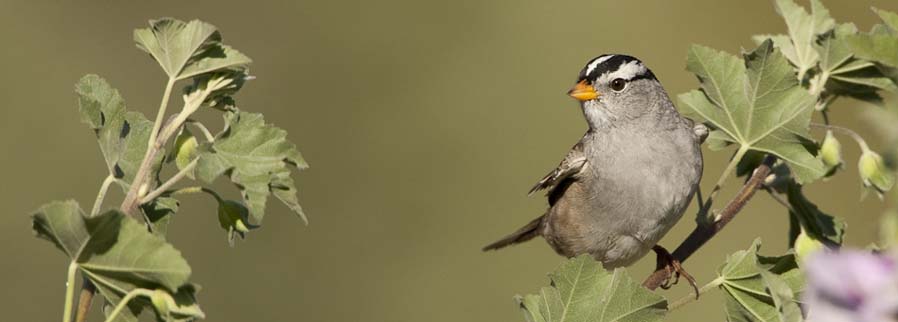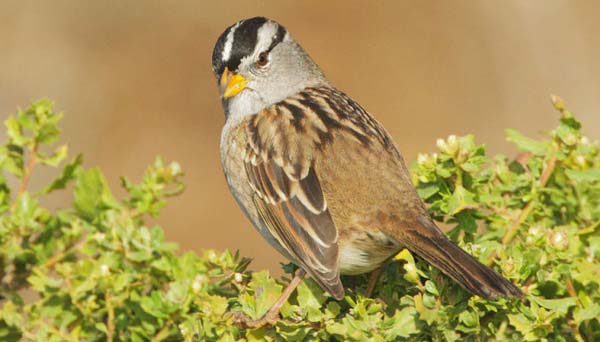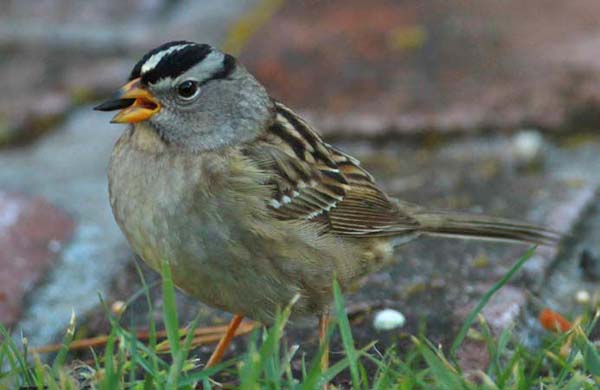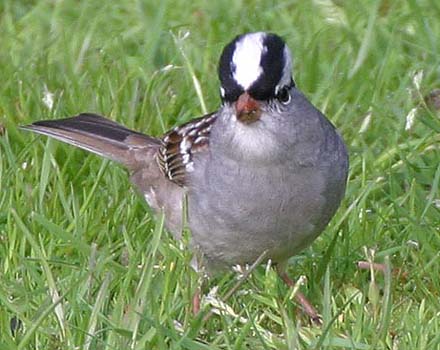Zonotrichia leucophrys
a web page by Don Roberson |
The preceding pages have presented some methods to attempt to distinguish between the three 'white-lored' subspecies of White-crowned Sparrow that occur in Monterey County. Focusing only on adults, a suite of characters was highlighted, using photos and a review of the literature. |
Take this one (right) from Pillar Pt., San Mateo Co., on 16 Oct 2009 (© Tom Grey). Nuttall's b reeds at Pillar Pt., but by early October any race could be here. To my eye this bird is clearly yellow-billed and the back pattern also easily rules out gambelii. So this is a problem between nuttalli and pugetensis. The back pattern is very crisp and contrasty, a point in favor of pugetensis, but in early fall all subspecies are in fresh plumage and I bet nuttalli could look this crisp then. The wing projection looks rather short to me, and the bill pretty big, suggesting nuttalli. The inner greater coverts and tertial edges are rather rich in color, favoring nuttalli. On the other had, the tone of the gray is rather pale, and contrast nicely with the brown flanks, like pugetensis, and the back is very crisp. So here is a bird that is difficult for me to identify. I really don't know what it is. |
We can easily rule out Gambel's on back pattern (black centers instead of dark red centers), so this is another Nuttall's vs. Puget Sound problem. To me the breast looks quite washed with brown, suggesting this bird is in its first-spring and still not completed prealternate molt (Pyle 1997 states it can continue into May, and even be completed on the summer grounds). So I see a gray head with black-and-white crown stripes (washed with gray in supercilium) but still a brown "immature" breast. If I am correct on this, than the presence of the malar stripe is not useful, as many first-year immatures have malar stripes. I can't evaluate the primary projection, but the back stripes look exceedingly crisp; the tertial edges and inner greater coverts look pretty dull; and the black crown stripes don't show any brown in them. All these characters favor Puget Sound. If this were a first-spring Nuttall's, I'd expect it to have brown in the black crown stripes. So I'm going to call this pugetensis, but not with a lot of confidence. [Blake sent a photo of another bird this same day — a full adult pugetensis — so it is apparent that Puget Sound winters in the yard.] If I am right about this, it means we still don't have any evidence from the Monterey Peninsula that Nuttall's wanders even one block away from the breeding habitat! |
 |
This
one (above) is another problem. Its a lovely shot from Carmel Valley on
7 Apr 2010 © Brian L. Sullivan (and featured on the eBird web
site). Carmel Valley is miles from any resident Nuttall's, so the
problem is Puget Sound vs. Gambel's. Is that bill yellow or orange?
Surely it is more orange than yellow? And yet.... the tone is a
yellow-orange to my eye, not a deeper orange with pink overtones. So
although the bill is a problem, perhaps one leans toward pugetensis. [On the other hand, only the tip of the bill is dark, a gambelii point?] We can see the bend of the wing — it looks white. Surely that favors gambelii?
Maybe — but perhaps the difference between them on this point is too
slim to be useful. To my eye the tone of the gray underparts is a paler
gray and contrast with brown flanks, favoring pugetensis. But
the most important distinction between these two — the back pattern —
is not visible. So it makes it hard to be confident about this photo.
Brian tells me that it was singing a pugetensis song. So that does
identify it — but it sure illustrates how difficult it can be to
evaluate bill color or try to use the color at the bend of the wing. |
A very similar subspecies, Z. l. oriantha, breeds in the mountains of California and throughout the montane West. Those populations winter in the deserts of the Southwest, including the deserts of southern California, and have occurred as vagrants to the coast. It is remotely possible that one could reach Monterey County some day. The bill color of leucophrys and oriantha is pink or reddish-pink. The back pattern recalls Gambel's: deep dark reddish centers with pale gray or even whitish edges. This particular bird has a lot of white on the throat, and it contrast with the decidedly darker pure gray underparts (again, in general, like Gambel's). More identification information is in Dunn, Garrett & Alderfer (1995). |
ACKNOWLEDGMENTS:
Many thanks for the photographers who allowed me to review their
excellent photos, and use a variety of them here: Tom Grey, Blake
Matheson, Brian L. Sullivan, and Glen Tepke. I appreciate discussions
about this i.d. topic, and corrections provided by Rita Carratello,
Kimball Garrett, Joe Morlan, Dan Singer, and Brian Sullivan. In sorting
out California distribution, Bill Bousman, Judith Dunham, Rob Fowler,
Tom Grey, Amy McDonald, and Rusty Scalf all provided helpful details. |
 Yet problems remain, and there will always be birds that defy confident identification.
Yet problems remain, and there will always be birds that defy confident identification.  Here
(right) is another one. This one is in a Pacific Grove yard on 7 Apr
2010 (© Blake Matheson). Although the Matheson yard is in the
Monterey Pine forest, it is only one block away from nuttalli
breeding habitat. Surely a Nuttall's could stray this far, especially
where seed is thrown out for sparrows. Given this setting, and the
early April date, it could be any subspecies.
Here
(right) is another one. This one is in a Pacific Grove yard on 7 Apr
2010 (© Blake Matheson). Although the Matheson yard is in the
Monterey Pine forest, it is only one block away from nuttalli
breeding habitat. Surely a Nuttall's could stray this far, especially
where seed is thrown out for sparrows. Given this setting, and the
early April date, it could be any subspecies. Here
in Monterey County we deal only with three "white-lored" races of
White-crowned Sparrow. In all of them the white supercilium color
(sometimes lightly washed with gray) continues to the bill. That
feature is different in the two "black-lored" races of White-crowned.
This is nominate leucophrys of eastern North America (right;
7 May 2004 at Boston, Massachusetts (photo © Glen Tepke). The
black in the upper half of the loral area (in front of the eye) cuts
off the white supercilium, so that the white color does not reach the
bill.
Here
in Monterey County we deal only with three "white-lored" races of
White-crowned Sparrow. In all of them the white supercilium color
(sometimes lightly washed with gray) continues to the bill. That
feature is different in the two "black-lored" races of White-crowned.
This is nominate leucophrys of eastern North America (right;
7 May 2004 at Boston, Massachusetts (photo © Glen Tepke). The
black in the upper half of the loral area (in front of the eye) cuts
off the white supercilium, so that the white color does not reach the
bill.